Filipina women value partners who share food because it reflects emotional connections and cultural traditions. Sharing meals shows generosity, respect, and care—qualities that deepen relationships. It strengthens family ties and fosters community engagement, creating lasting memories around the dining table. Food becomes a love language, expressing appreciation and nurturing intimacy. When you embrace this practice, you embrace an essential part of Filipino culture. Discover more about the significance of food sharing in building bonds and connections.
Key Takeaways
- Shared meals signify emotional connections, making partners who value food sharing more appealing to Filipina women.
- Food sharing reflects generosity and care, qualities Filipina women appreciate in a partner.
- Participating in communal dining showcases respect and fosters unity, aligning with cultural values important to Filipina women.
- Cooking together builds teamwork and strengthens bonds, enhancing the relationship between partners.
- Sharing culinary experiences deepens appreciation for heritage, fostering a sense of belonging and trust in the relationship.
The Importance of Food Sharing in Filipino Culture

When you explore Filipino culture, you’ll quickly discover that food sharing isn’t just a tradition; it’s an essential part of community life. It serves as a social lubricant, strengthening bonds among family and friends.
Practices like *kamayan* and *salu-salo* encourage direct interaction, making meals more engaging and meaningful. Generosity is at the heart of Filipino hospitality, where offering food symbolizes respect and care.
You might notice that excess food is often prepared, ensuring everyone has enough to eat, and leftovers are commonly sent home as a gesture of goodwill.
The act of sharing meals transcends mere sustenance; it’s a way to express cultural identity, preserve traditions, and promote unity within the community, reinforcing the values of love and togetherness.
Building Emotional Connections Through Shared Meals
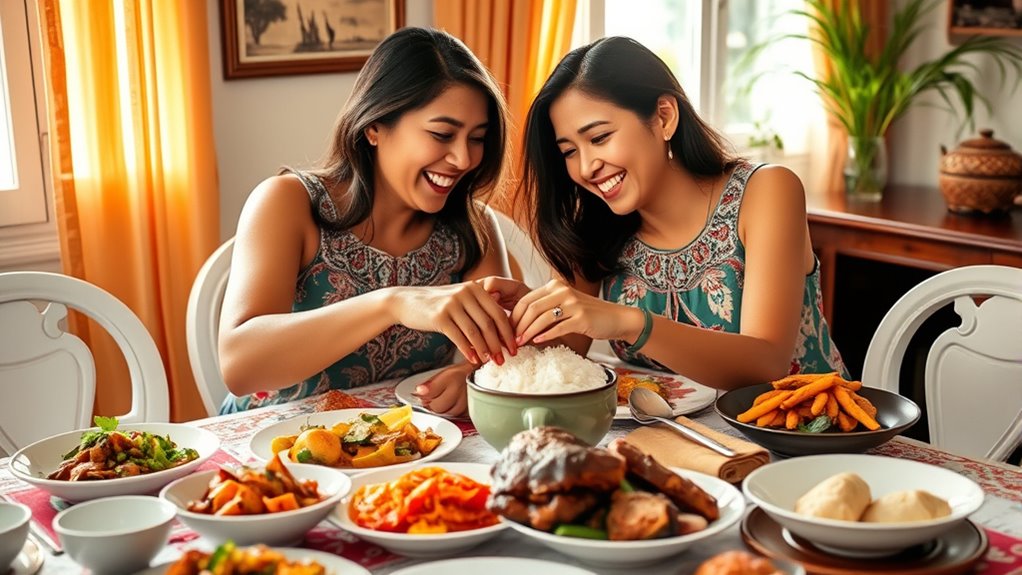
Sharing meals not only nourishes the body but also fosters deep emotional connections among individuals. When you gather around the table, you create opportunities for meaningful conversations, enhancing your relationships and building trust.
Frequent shared meals can reduce feelings of loneliness and improve your overall mood, making you feel more connected to those around you. This practice strengthens family bonds and nurtures a sense of community, allowing you to share stories and preserve cultural traditions.
As you enjoy meals together, you’ll likely notice an uplift in your emotional well-being. Ultimately, these gatherings not only promote happiness but also contribute substantially to your mental health, creating a foundation of support and intimacy in your relationships. Additionally, practicing stress management techniques during these shared moments can further enhance your emotional connections.
Food as a Love Language in Relationships
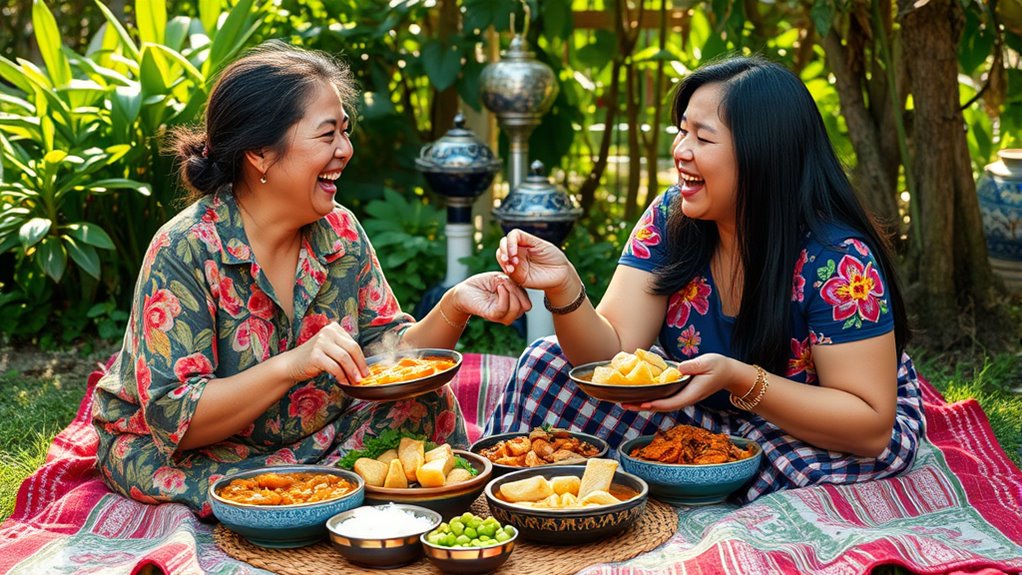
Food serves as a profound love language, expressing affection in ways that words often cannot. When you cook or share meals, you show thoughtfulness and care, deepening your emotional connection with your partner.
This practice is especially significant in many cultures, including Filipino culture, where food symbolizes hospitality and love. Sharing a meal creates memorable experiences that foster intimacy and strengthen your bond. The effort you put into preparing a dish conveys your feelings without needing to say a word.
Additionally, food acts as non-verbal communication, allowing you to express love and concern. However, remember to maintain balance; while food is powerful, it’s essential not to rely solely on it for emotional fulfillment in your relationship.
Strengthening Family Ties Through Shared Dining Experiences
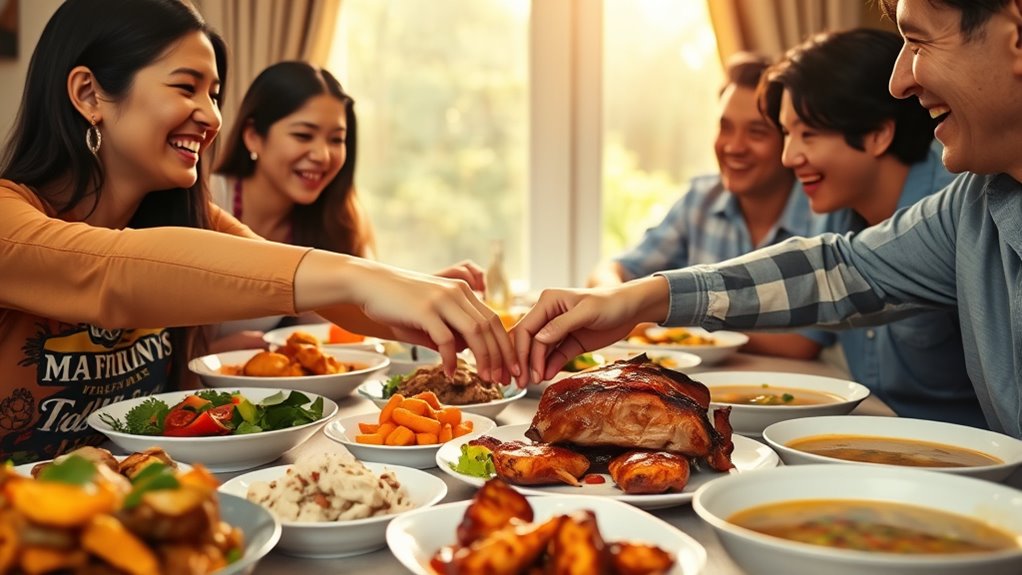
As families gather around the dining table, they strengthen their bonds through shared meals that embody love and tradition. In Filipino culture, these meals are more than just food; they symbolize unity and heritage.
The dining table becomes a hub for laughter and conversation, creating lasting memories. Traditional practices like *kamayan* highlight the joy of eating together, while modern adaptations keep the experiences fresh.
Regular family meals, from breakfast to dinner, guarantee continuity and shared moments. Involving everyone in meal preparation fosters teamwork and respect, reinforcing connections.
These dining experiences not only celebrate special occasions but also provide emotional support, enhancing the sense of belonging and strengthening family ties for generations to come.
The Role of Generosity in Filipino Hospitality
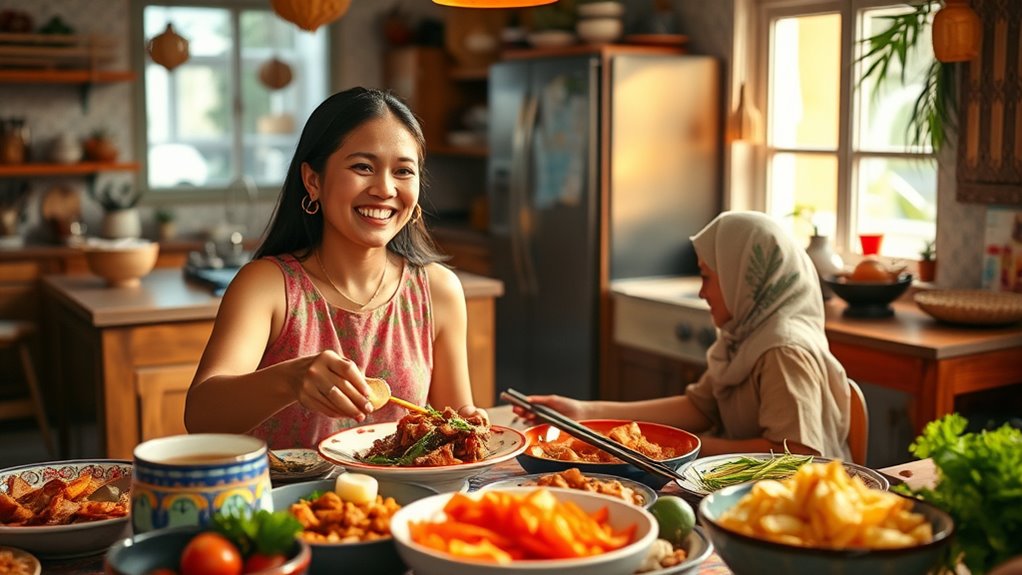
Generosity lies at the heart of Filipino hospitality, creating an inviting atmosphere where everyone feels welcome. When you step into a Filipino home, you’ll often find the host enthusiastic to share meals, reflecting a deep commitment to your comfort.
This culture of giving transcends socio-economic boundaries, with families welcoming guests without hesitation. The phrase *tuloy po kayo* perfectly captures this warm spirit, making you feel instantly at home.
Sharing food not only fosters social bonds but also expresses cultural identity, reinforcing the importance of community. From communal dining practices like boodle fights to sharing leftovers, every act of generosity strengthens relationships and creates lasting connections.
In this way, Filipino hospitality becomes a beautiful blend of kindness and warmth. Additionally, the importance of community support in fostering these connections cannot be overstated, as it contributes significantly to the overall experience of togetherness.
Culinary Identity and Its Impact on Partner Selection
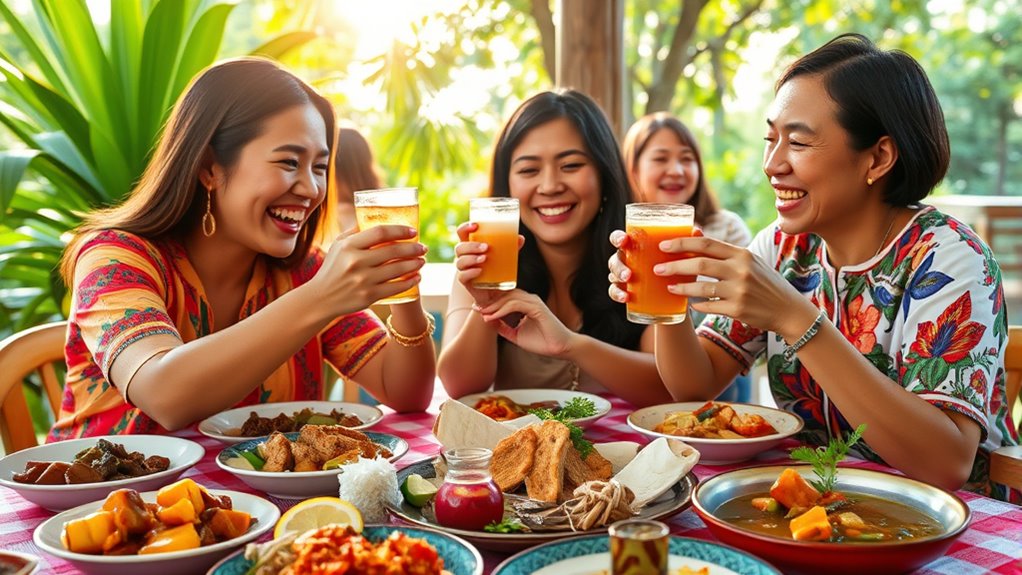
In the vibrant tapestry of Filipino culture, culinary identity weaves together flavors and traditions that shape interpersonal relationships, especially in partner selection.
When you share meals, it signals social compatibility and reflects your values of generosity and hospitality. Partners who appreciate traditional dishes often align culturally, making them more appealing.
Eating together fosters emotional connections and intimacy, essential in building relationships. Furthermore, sharing food symbolizes a willingness to share resources—an important quality in any partnership.
Including your partner in family meals can pave the way for family acceptance, which holds significant weight in Filipino culture. By valuing culinary traditions, you deepen bonds and showcase respect for heritage, enhancing your partner selection process.
Sharing Food as a Means of Community Engagement
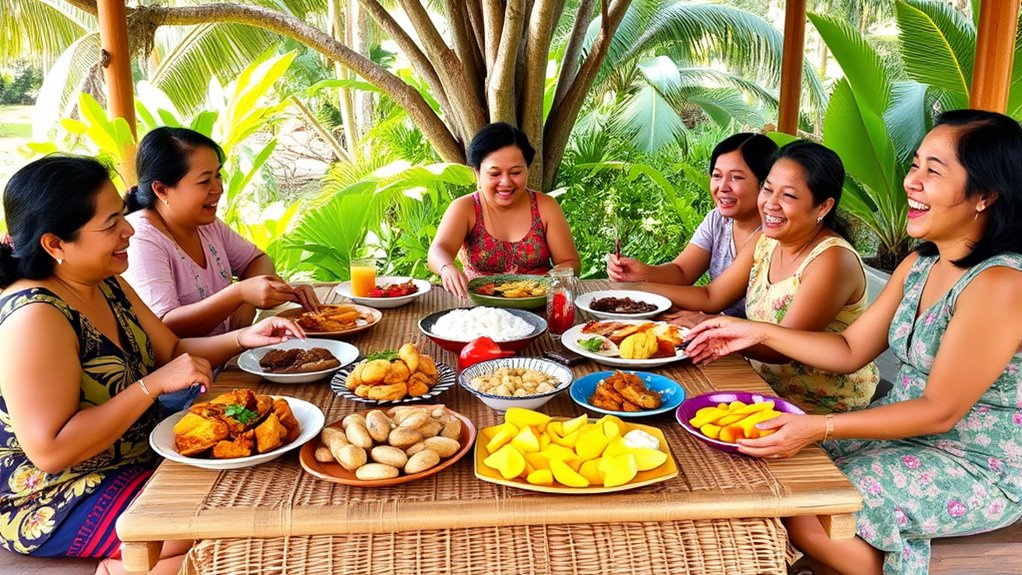
While many mightn’t realize it, sharing food serves as a powerful vehicle for community engagement. When you participate in food-sharing events, you help create connections among neighbors and foster social bonds.
These gatherings often promote cross-cultural interactions, allowing you to explore diverse culinary traditions. By engaging in local food initiatives, you support the consumption of locally grown produce, enhancing food security in your community.
Shared meals provide a platform for outreach and social support, strengthening community ties. Furthermore, initiatives like food banks and trading posts redistribute surplus food, bridging economic gaps.
Through food sharing, you not only nourish yourself but also contribute to a vibrant, cohesive community that values hospitality and respect. Engaging in these activities can also promote emotional health, providing a sense of belonging and reducing feelings of isolation.
Empowerment of Women in Food Preparation and Sharing
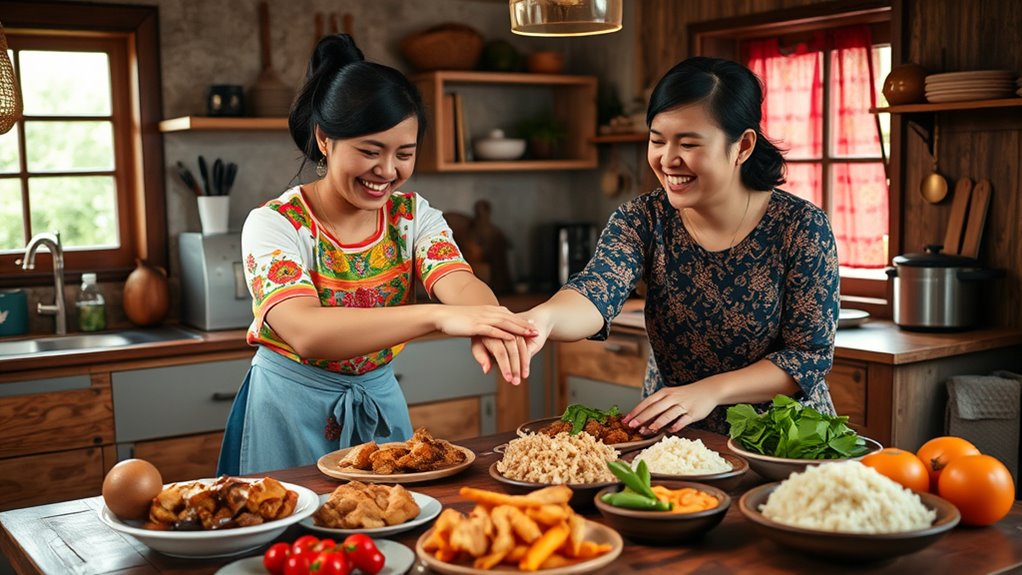
Sharing food not only strengthens community bonds but also empowers women in significant ways.
Historical figures like Maria Ylagan Orosa inspire you by showcasing innovation in food preparation and preservation. Her work emphasizes food independence, helping communities rely less on imports. This focus on food independence is essential for fostering self-sufficiency within communities. Additionally, utilizing herbal infusion machines can streamline the process of creating traditional dishes, allowing for greater efficiency and creativity.
Women play vital roles in food production, contributing to local economies and promoting sustainable practices. By participating in food systems, you create entrepreneurial opportunities, enhancing economic empowerment. This involvement challenges gender norms, allowing women to express their creativity and leadership in the culinary world. Additionally, incorporating nutrient-dense ingredients like chia seeds into traditional recipes can enhance health and well-being, supporting overall community vitality.
Women are essential in food production, driving local economies and fostering sustainability while creating entrepreneurial opportunities for empowerment.
Sharing Filipino cuisine globally highlights women’s contributions and builds bridges between cultures.
Through food, you not only nurture your community but also cultivate lasting legacies for future generations.
The Legacy of Recipes and Cultural Continuity

Though Filipino cuisine has evolved through diverse historical influences, its recipes remain essential in maintaining cultural continuity. You’ll find that these recipes, rich with Malay, Chinese, Spanish, and American flavors, symbolize hospitality and community. They’re often passed down orally, ensuring that traditions stay alive. In many cultures, including Brazilian cuisine, food reflects cultural influences that shape culinary identity. Additionally, the care and attention given to meal preparation can mirror the ultimate hamster care guide that emphasizes the importance of nurturing and attention in maintaining well-being. Furthermore, the celebration of halal living showcases how food can unite communities across different cultures.
When you gather with family over shared meals, you’re not just enjoying food; you’re participating in a legacy. Innovative adaptations keep dishes relevant, while traditional cooking techniques like grilling and stewing anchor them in history. This shared experience of food also reflects the importance of emotional and psychological growth, as it fosters connections and strengthens relationships within families. Sharing meals can also serve as a form of good grief, allowing individuals to process emotions and build support systems during difficult times.
As you embrace these recipes, you connect with your cultural identity, bridging your heritage with contemporary life. This culinary continuity fosters a deep sense of belonging, reflecting the heart and soul of Filipino culture.
Food Sharing as a Reflection of Mutual Respect and Gratitude
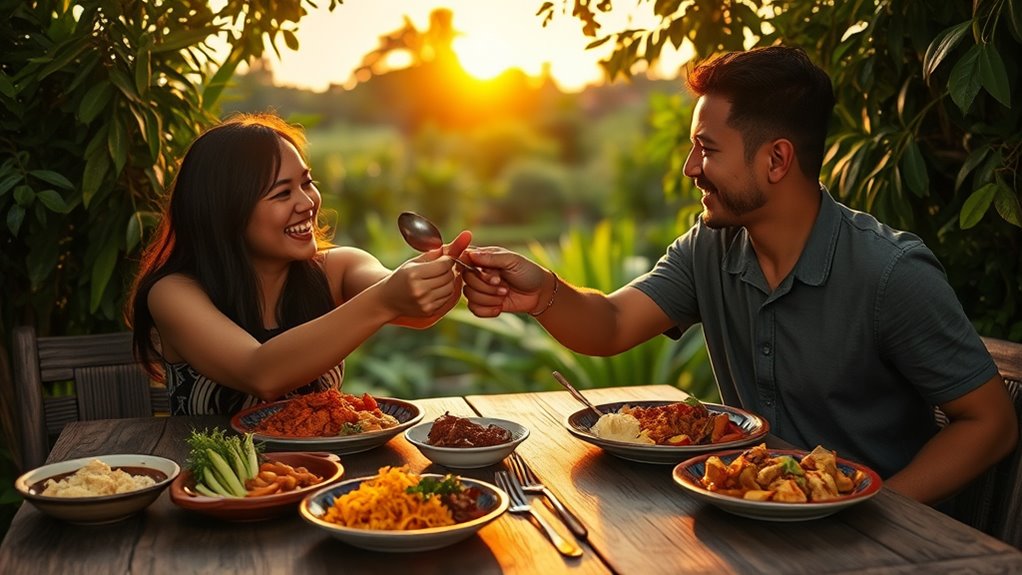
Gathering around a table filled with food embodies more than just a meal; it reflects deep-seated values of mutual respect and gratitude within Filipino culture.
When you share food, you strengthen community bonds and demonstrate generosity, essential for nurturing relationships. This practice isn’t merely about nourishment; it’s a chance for social interaction and cultural expression.
By sharing meals, you show appreciation for the effort someone put into cooking and reinforce family ties. Each shared dish symbolizes trust and care, enhancing emotional connections.
Sharing meals deepens appreciation for the cook’s effort, strengthens family bonds, and enriches emotional connections.
Ultimately, food sharing fosters a sense of belonging, celebrates cultural heritage, and highlights the importance of gratitude in your relationships, ensuring that the tradition of generosity remains alive and cherished.
Frequently Asked Questions
How Does Food Sharing Influence Romantic Relationships in Filipino Culture?
Food sharing greatly influences romantic relationships in Filipino culture.
When you share meals, you create a sense of intimacy and connection, deepening your bond. It’s not just about the food itself; it’s about the experiences and memories you build together.
What Types of Food Are Commonly Shared During Filipino Gatherings?
Imagine you’re at a vibrant Filipino fiesta, surrounded by laughter and music.
You’ll notice that rice is always at the center of the table, accompanied by adobo, a savory chicken or pork dish.
Pancit, with its colorful noodles, often steals the spotlight during celebrations.
Don’t forget the lechon, a succulent roasted pig, which becomes the centerpiece of any gathering.
Sharing these dishes creates a warm atmosphere, emphasizing community and togetherness in every bite.
Are There Specific Rituals Associated With Food Sharing Among Couples?
When you share food as a couple, you create meaningful rituals that deepen your connection.
Inviting your partner to eat with phrases like “kain tayo” fosters inclusivity. You both observe respectful table manners, enhancing the experience.
Expressing gratitude with “salamat po” adds warmth, while communal eating rituals strengthen intimacy.
These practices not only enrich your relationship but also honor cultural traditions, making every meal a cherished time of bonding and shared experiences.
How Do Food Preferences Affect Partner Compatibility in Filipino Culture?
Food preferences can be the secret ingredient that spices up partner compatibility in Filipino culture. When you and your partner share similar tastes, it’s like finding a perfect melody in a song.
Enjoying traditional dishes together, whether it’s adobo or sinigang, strengthens your bond and creates lasting memories. Plus, being open to diverse regional cuisines shows adaptability, making you more compatible.
Ultimately, shared food experiences enrich your relationship, deepening connections and fostering love.
Can Sharing Food Improve Communication Between Partners?
Yes, sharing food can definitely improve communication between partners.
When you enjoy a meal together, it creates a relaxed atmosphere that encourages open dialogue. You might find that sharing bites leads to more engaging conversations, enhancing your connection.
Plus, when you both eat similar dishes, it can foster a sense of unity and understanding.
This shared experience not only satisfies hunger but also strengthens your bond through meaningful interactions and mutual enjoyment.
Conclusion
In Filipino culture, sharing food isn’t just about nourishment; it’s a heartfelt way to connect and show love. When you sit down to a meal together, it’s like exchanging little pieces of your life, creating bonds that feel as strong as a family heirloom passed through generations. So, if you’re lucky enough to share a meal with a Filipina, remember, you’re not just enjoying food—you’re part of something deeper, a beautiful tapestry of tradition and connection.









